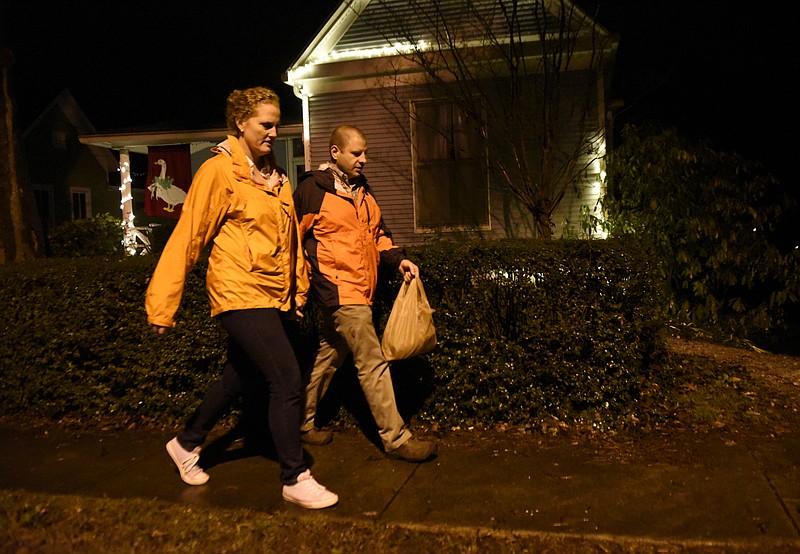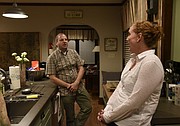More Info
Pro tipsHere are some suggestions from marriage therapists and professional organizers to ease the post-nuptial stress of merging households:* Negotiate the decor. Whether moving into one spouse’s current house or into an entirely new one, both spouses should openly discuss the best way to blend their possessions to equally represent their respective styles.* Just remember: “It’s only stuff.” Your spouse is bringing a lifetime of possessions with them into the marriage, and they’ll probably feel an attachment to some of it. Be willing to make room for their prized possessions and, if space is an issue, be open to sacrificing some of your own things to clear space or to buying a new item together.* Be creative … and patient. Blending households does not have to be — nor can it be, in some cases — an overnight process. Find ways to use each spouse’s personal possessions to fill empty spaces early on, and take solace knowing that some of the current decorations will likely be replaced by new ones chosen by you and your spouse.* Bring in a (neutral) third party. Having an objective set of eyes, such as a professional organizer, can help determine whether sentimental value is really worth the square footage.* Consider additional storage. In cases where a spouse simply can’t give up a possession and there’s no space to store it in the house, renting a storage unit can offer a short-term solution that lets couples re-evaluate after adjusting to their new living situation. This is also a handy solution for stowing away seasonal items.Source: Brides.com, Sparefoot.com
More Info
The waiting gameThe median age at which couples get married has been on the rise for decades and is now the highest it’s been in 125 years. Here’s the timeline for when people used to say “I do”:Men Women* 1890: 26.1 years/22 years* 1910: 25.1 years/21.6 years* 1920: 24.6 years/21.2 years* 1940: 24.3 years/21.5 years* 1950: 22.8 years/20.3 years* 1970: 23.2 years/20.8 years* 1980: 24.7 years/22.0 years* 1990: 26.1 years/23.9 years* 2000: 26.8 years/25.1 years* 2010: 28.2 years/26.1 yearsSource: U.S. Census
More Info
The things they lost …Some of the prized possessions readers said they had to give up after they got married:“My ‘just for me’ private space to just chill and relax.” — Mark Carter“I had a 1961 baby blue Plymouth convertible. One day after we married, the car was gone. Don’t know what he did with it. It was just gone. I miss that car!” — Joanne Mockus Leach“Space. I went from living on a farm in the country to a house in the city.” — Tim Hooker“Space and taming my obsessive compulsive disorder. Lol.” — Shellie Lee“I had to give up bad cooking. My wife is a genius in the kitchen.” — Curtis Harris
Carl and Jennifer Sheffield knew early on in their relationship that they had plenty of points of compatibility.
He was 40; she was 41. Her dad was a doctor; his was a dentist. Neither had ever been married. They shared ties to Texas and Mississippi and were focused on faith and physical fitness.
After a two-year courtship, they married in August 2013 - then faced the daunting prospect of combining their households. At almost 20 years older than the average American newlyweds, they'd accumulated more possessions than most couples, which experts say could have made an already-difficult task even harder.
"Couples getting married at older ages definitely bring more stuff into a marriage. For some, this may deter an interest in marriage," says Hayne Steen, a marriage and family therapist at Elbow Tree Christian Counseling on Broad Street.
"For others who feel called to marriage, their possessions can become a very practical adventure for learning about one another. Choosing what to keep and what to let go of can be a very powerful tool for becoming a new family."
Still, before Jennifer felt comfortable moving from her house on the North Shore into Carl's place in St. Elmo, she had a few issues she wanted to address.
There was an almost complete lack of overhead lighting in his home; his library of programming manuals and theology and athletic guides sprawled haphazardly across three bookshelves in a living room that served double duty as an office. The adjoining dining room was dominated by - and color-coordinated to - his beloved forest green-felted pool table.
"There were some things about this house that were very boyish," says Jennifer, who works as the director of finance, accounting and administration at the Generosity Trust. "I was like, 'Well, how can we make this feel like not the bachelor pad?'"
After their honeymoon, the couple crammed themselves into Jennifer's home, rolled up their sleeves and started renovating Carl's house. By the time they moved into the bungalow a year later, the floor plan was more open, the pool table (yes, the beloved pool table) and many of his books had been sold. The decor was "really girled up a lot," Carl laughs.
More importantly, he adds, the house felt like a different place, one which reflected both of them.
"Making the house new to both people is important," Carl says. "It was my house, and now it's our house. The end product is more than worth giving up stuff."
Learning to let go
The transition into a combined household wasn't entirely painless, however, and Carl wasn't the only one to make sacrifices for the sake of marital harmony.
Jennifer recalls feeling a few twinges at having to give up some of her furniture, including a pair of twin beds that had belonged to her grandparents.
"I had a lot of sentimental attachment to those beds, but I was like, 'We are never going to have a room, if we stay here after doing all the [renovating], where those beds will fit," she says. "I guess I was bummed for a few days but, at the end of the day, I'd much rather have a house that is livable and good. We were both willing to let go of things for our relationship."
The wholesaler who bought Carl's pool table let him keep the felt, which is now sentimentally stowed away in the basement for some sort of future use, but he says he doesn't regret letting the table go.
"When you live for a while either single or divorced, you get attached to different things and, if they don't fit within the new family unit structure, you have to consider your priorities," he says. "Would I rather have a pool table or someone to come home to? I'll take someone to come home to."
To fill the billiards-shaped void in the house, the couple had a friend build a formal dining table with a barn-paneled top and a metal base. It's a design they say equally represents their respective tastes.
Older, wiser
They didn't realize it at the time, but the Sheffields' approach to blending their households followed many of the suggestions relationship and decluttering experts make to couples who struggle with the process.
One of the most helpful tools at their disposal - and one experts suggest most couples consider - was using an impartial design consultant without any emotional attachment to their stuff; someone who won't muddy their perspective. In the Sheffields' case, another friend fit the bill.
"She came in and measured in all the rooms and looked at all Carl's furniture and then all my furniture," Jennifer says. "She was like, 'For the best feel in the home, you're only going to want this piece of furniture in this room versus holding on to something just because you want to keep it.' That helped a lot."
Steen says couples who successfully deal with tangible complications like deciding together how to divide their possessions and decorate their home often are better equipped to handle emotional issues as well.
"As couples make the pivot toward the covenant of marriage, they intuitively invest the majority of their energy dealing with these areas," he says. "To avoid or ignore any of these could be a recipe for disaster. Simply dealing with our external stuff often can reveal new opportunities for us to face our internal stuff."
Before meeting each other, Carl and Jennifer say they had both made peace with the idea of never settling down with someone else. Despite having more time than most couples to forge separate lives, however, they say marrying later in life actually made the process of combining households much smoother.
"[Getting married younger] would have been easier in that we wouldn't have had stuff we were attached to, but it would have been harder in the sense that I probably would have been less mature [and] more selfish," Jennifer says. "Life teaches you what matters and what things to put your energy into as you grow up."
Contact Casey Phillips at cphillips@timesfreepress.com or 423-757-6205. Follow him on Twitter at @PhillipsCTFP.

